Systems Engineering Project: Functional Analysis and Allocation Report
VerifiedAdded on 2023/04/03
|14
|2582
|233
Report
AI Summary
This report provides a comprehensive overview of Functional Analysis and Allocation (FA&A) within the context of systems engineering. It begins with an introduction to FA&A, emphasizing its role in understanding system functions, priorities, and challenges. The report then details the FA&A process, including its purpose, inputs (customer needs, requirements), and outputs (specifications, baselines). It covers system lifecycle staging and supporting processes like requirement analysis and system verification. The report explores various approaches to functional analysis, such as requirement analysis, functional partitioning, timeline analysis, and the use of functional flow block diagrams. Furthermore, it discusses approaches to functional allocation, including design synthesis, functional architecture, and requirements allocation. The report emphasizes the sequential and iterative nature of FA&A, highlighting its importance in transforming system requirements into a coherent system description. The report concludes by summarizing the key aspects of FA&A and its significance in systems engineering design.
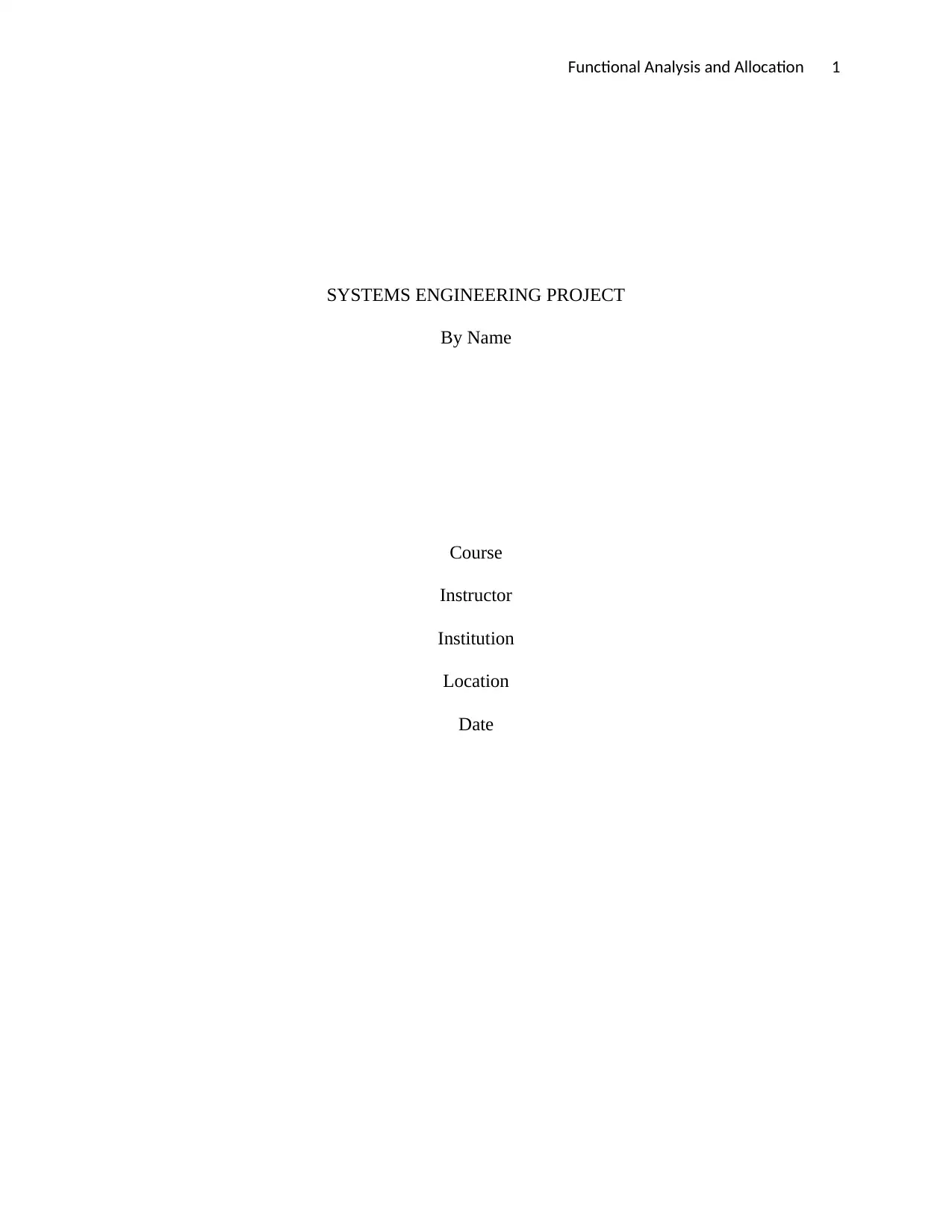
Functional Analysis and Allocation 1
SYSTEMS ENGINEERING PROJECT
By Name
Course
Instructor
Institution
Location
Date
SYSTEMS ENGINEERING PROJECT
By Name
Course
Instructor
Institution
Location
Date
Paraphrase This Document
Need a fresh take? Get an instant paraphrase of this document with our AI Paraphraser

Functional Analysis and Allocation 2
Table of Contents
INTRODUCTION...........................................................................................................................................2
FA&A PROCESS OVERVIEW..........................................................................................................................2
Purpose...................................................................................................................................................3
Input........................................................................................................................................................3
Output.....................................................................................................................................................3
System Life-cycle Staging.........................................................................................................................3
Supporting processes..............................................................................................................................4
APPROACHES FOR FUNCTIONAL ANALYSIS.................................................................................................4
Requirement Analysis..............................................................................................................................5
Functional Partitioning............................................................................................................................5
Timeline Analysis.....................................................................................................................................6
Functional Flow Block Diagram................................................................................................................7
APPROACHES FOR FUNCTIONAL ALLOCATION............................................................................................8
Design Synthesis......................................................................................................................................8
Functional Architecture...........................................................................................................................9
Requirements Allocation.......................................................................................................................10
CONCLUSION.............................................................................................................................................11
Table of Contents
INTRODUCTION...........................................................................................................................................2
FA&A PROCESS OVERVIEW..........................................................................................................................2
Purpose...................................................................................................................................................3
Input........................................................................................................................................................3
Output.....................................................................................................................................................3
System Life-cycle Staging.........................................................................................................................3
Supporting processes..............................................................................................................................4
APPROACHES FOR FUNCTIONAL ANALYSIS.................................................................................................4
Requirement Analysis..............................................................................................................................5
Functional Partitioning............................................................................................................................5
Timeline Analysis.....................................................................................................................................6
Functional Flow Block Diagram................................................................................................................7
APPROACHES FOR FUNCTIONAL ALLOCATION............................................................................................8
Design Synthesis......................................................................................................................................8
Functional Architecture...........................................................................................................................9
Requirements Allocation.......................................................................................................................10
CONCLUSION.............................................................................................................................................11
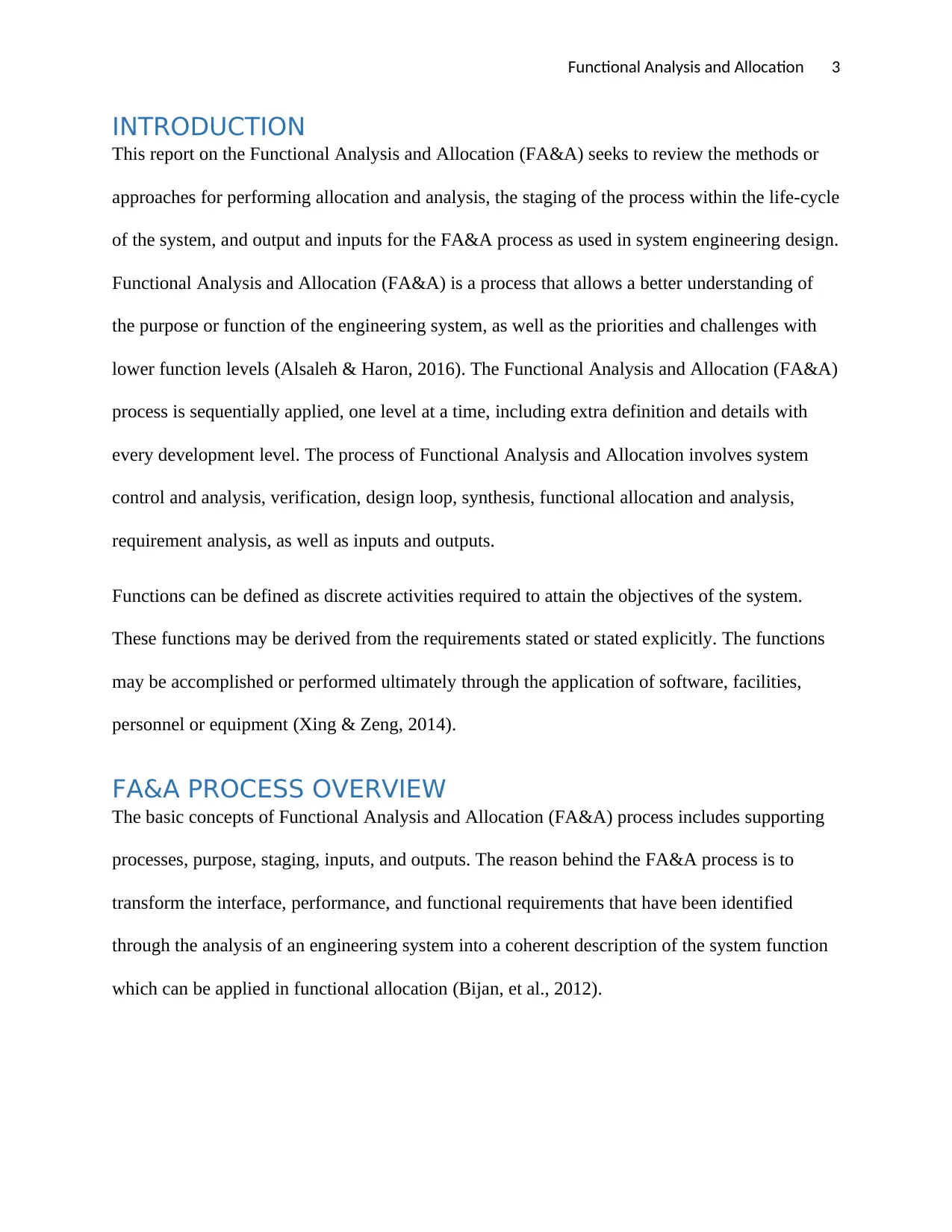
Functional Analysis and Allocation 3
INTRODUCTION
This report on the Functional Analysis and Allocation (FA&A) seeks to review the methods or
approaches for performing allocation and analysis, the staging of the process within the life-cycle
of the system, and output and inputs for the FA&A process as used in system engineering design.
Functional Analysis and Allocation (FA&A) is a process that allows a better understanding of
the purpose or function of the engineering system, as well as the priorities and challenges with
lower function levels (Alsaleh & Haron, 2016). The Functional Analysis and Allocation (FA&A)
process is sequentially applied, one level at a time, including extra definition and details with
every development level. The process of Functional Analysis and Allocation involves system
control and analysis, verification, design loop, synthesis, functional allocation and analysis,
requirement analysis, as well as inputs and outputs.
Functions can be defined as discrete activities required to attain the objectives of the system.
These functions may be derived from the requirements stated or stated explicitly. The functions
may be accomplished or performed ultimately through the application of software, facilities,
personnel or equipment (Xing & Zeng, 2014).
FA&A PROCESS OVERVIEW
The basic concepts of Functional Analysis and Allocation (FA&A) process includes supporting
processes, purpose, staging, inputs, and outputs. The reason behind the FA&A process is to
transform the interface, performance, and functional requirements that have been identified
through the analysis of an engineering system into a coherent description of the system function
which can be applied in functional allocation (Bijan, et al., 2012).
INTRODUCTION
This report on the Functional Analysis and Allocation (FA&A) seeks to review the methods or
approaches for performing allocation and analysis, the staging of the process within the life-cycle
of the system, and output and inputs for the FA&A process as used in system engineering design.
Functional Analysis and Allocation (FA&A) is a process that allows a better understanding of
the purpose or function of the engineering system, as well as the priorities and challenges with
lower function levels (Alsaleh & Haron, 2016). The Functional Analysis and Allocation (FA&A)
process is sequentially applied, one level at a time, including extra definition and details with
every development level. The process of Functional Analysis and Allocation involves system
control and analysis, verification, design loop, synthesis, functional allocation and analysis,
requirement analysis, as well as inputs and outputs.
Functions can be defined as discrete activities required to attain the objectives of the system.
These functions may be derived from the requirements stated or stated explicitly. The functions
may be accomplished or performed ultimately through the application of software, facilities,
personnel or equipment (Xing & Zeng, 2014).
FA&A PROCESS OVERVIEW
The basic concepts of Functional Analysis and Allocation (FA&A) process includes supporting
processes, purpose, staging, inputs, and outputs. The reason behind the FA&A process is to
transform the interface, performance, and functional requirements that have been identified
through the analysis of an engineering system into a coherent description of the system function
which can be applied in functional allocation (Bijan, et al., 2012).
⊘ This is a preview!⊘
Do you want full access?
Subscribe today to unlock all pages.

Trusted by 1+ million students worldwide

Functional Analysis and Allocation 4
Purpose
The major purpose of FA&A process in an engineering system is to enable a better
understanding of the purpose or function of the engineering system, as well as the priorities and
challenges with lower function levels. This can be attained through the functional arrangement of
systems in a logical sequence, higher level function decomposition into functions of a lower
level, and then performance allocation to lower level functions from higher level functions. The
FA&A process enables traceability to the solution description from requirements which are the
results of design synthesis.
Input
The inputs can be defined as the outputs if the requirement analysis. The inputs of the FA&A
process is composed of the constraints encountered, customer needs, requirements, and
objectives of the project (Anyaeche & Oluleye, 2011). The FA&A process inputs entail
parameters such as technology available, effectiveness measurements, missions, and the
environment.
Output
The output of the FA&A process entails any data that regulates or illustrates the configurations o
the product or processes required during product development. The output of the process
depends on the level of development and entails baselines, decision database, specifications, and
items configurations (Pfannendörfer, 2010).
System Life-cycle Staging
The staging of the system lifecycle during the FA&A process entails the activities of the
technical management needed to select, evaluate, and measure progress and choose alternatives.
The activities involve during lifecycle staging include design analysis, effectiveness analysis,
and trade-off studies. (Alsaleh & Haron, 2016)The first step in lifecycle staging is the analysis of
Purpose
The major purpose of FA&A process in an engineering system is to enable a better
understanding of the purpose or function of the engineering system, as well as the priorities and
challenges with lower function levels. This can be attained through the functional arrangement of
systems in a logical sequence, higher level function decomposition into functions of a lower
level, and then performance allocation to lower level functions from higher level functions. The
FA&A process enables traceability to the solution description from requirements which are the
results of design synthesis.
Input
The inputs can be defined as the outputs if the requirement analysis. The inputs of the FA&A
process is composed of the constraints encountered, customer needs, requirements, and
objectives of the project (Anyaeche & Oluleye, 2011). The FA&A process inputs entail
parameters such as technology available, effectiveness measurements, missions, and the
environment.
Output
The output of the FA&A process entails any data that regulates or illustrates the configurations o
the product or processes required during product development. The output of the process
depends on the level of development and entails baselines, decision database, specifications, and
items configurations (Pfannendörfer, 2010).
System Life-cycle Staging
The staging of the system lifecycle during the FA&A process entails the activities of the
technical management needed to select, evaluate, and measure progress and choose alternatives.
The activities involve during lifecycle staging include design analysis, effectiveness analysis,
and trade-off studies. (Alsaleh & Haron, 2016)The first step in lifecycle staging is the analysis of
Paraphrase This Document
Need a fresh take? Get an instant paraphrase of this document with our AI Paraphraser
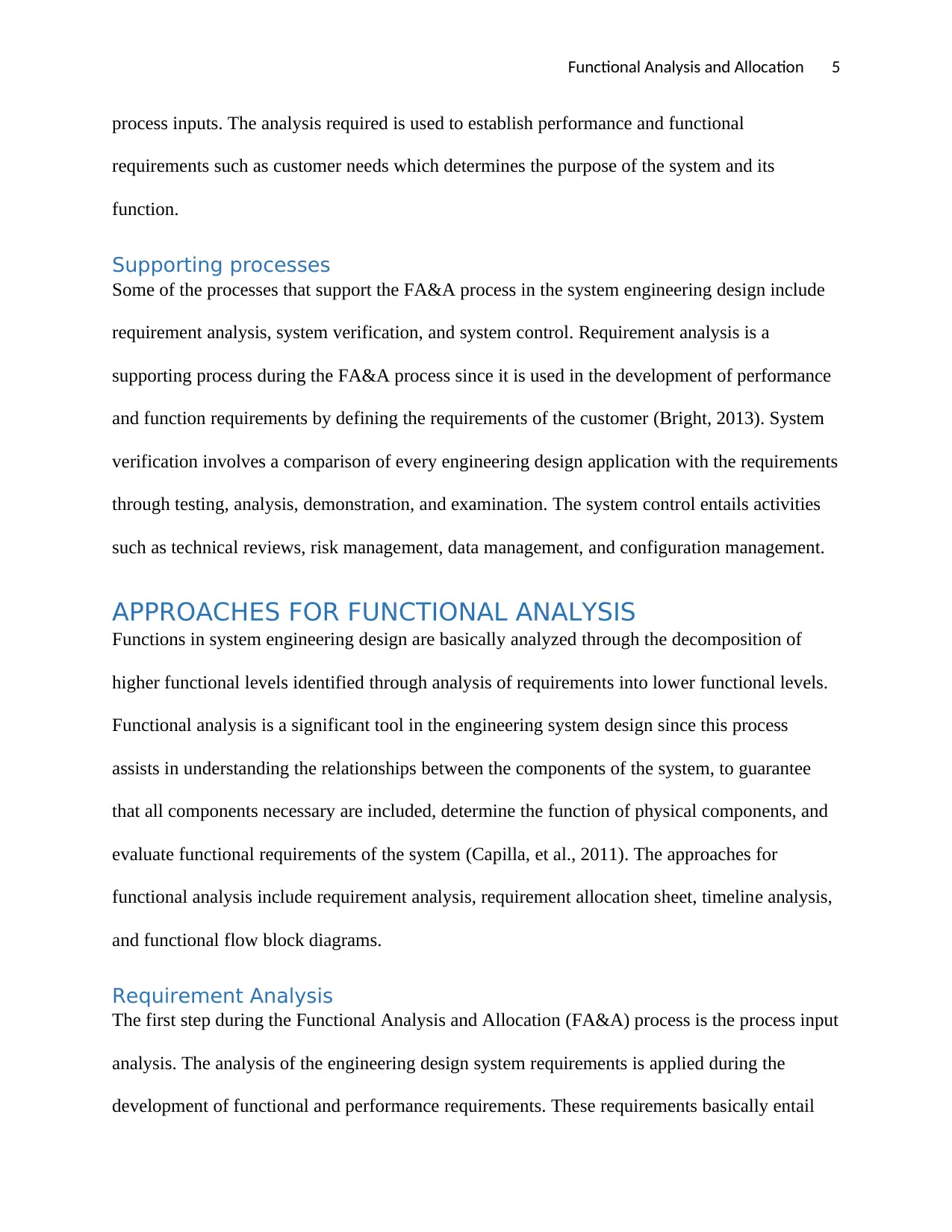
Functional Analysis and Allocation 5
process inputs. The analysis required is used to establish performance and functional
requirements such as customer needs which determines the purpose of the system and its
function.
Supporting processes
Some of the processes that support the FA&A process in the system engineering design include
requirement analysis, system verification, and system control. Requirement analysis is a
supporting process during the FA&A process since it is used in the development of performance
and function requirements by defining the requirements of the customer (Bright, 2013). System
verification involves a comparison of every engineering design application with the requirements
through testing, analysis, demonstration, and examination. The system control entails activities
such as technical reviews, risk management, data management, and configuration management.
APPROACHES FOR FUNCTIONAL ANALYSIS
Functions in system engineering design are basically analyzed through the decomposition of
higher functional levels identified through analysis of requirements into lower functional levels.
Functional analysis is a significant tool in the engineering system design since this process
assists in understanding the relationships between the components of the system, to guarantee
that all components necessary are included, determine the function of physical components, and
evaluate functional requirements of the system (Capilla, et al., 2011). The approaches for
functional analysis include requirement analysis, requirement allocation sheet, timeline analysis,
and functional flow block diagrams.
Requirement Analysis
The first step during the Functional Analysis and Allocation (FA&A) process is the process input
analysis. The analysis of the engineering design system requirements is applied during the
development of functional and performance requirements. These requirements basically entail
process inputs. The analysis required is used to establish performance and functional
requirements such as customer needs which determines the purpose of the system and its
function.
Supporting processes
Some of the processes that support the FA&A process in the system engineering design include
requirement analysis, system verification, and system control. Requirement analysis is a
supporting process during the FA&A process since it is used in the development of performance
and function requirements by defining the requirements of the customer (Bright, 2013). System
verification involves a comparison of every engineering design application with the requirements
through testing, analysis, demonstration, and examination. The system control entails activities
such as technical reviews, risk management, data management, and configuration management.
APPROACHES FOR FUNCTIONAL ANALYSIS
Functions in system engineering design are basically analyzed through the decomposition of
higher functional levels identified through analysis of requirements into lower functional levels.
Functional analysis is a significant tool in the engineering system design since this process
assists in understanding the relationships between the components of the system, to guarantee
that all components necessary are included, determine the function of physical components, and
evaluate functional requirements of the system (Capilla, et al., 2011). The approaches for
functional analysis include requirement analysis, requirement allocation sheet, timeline analysis,
and functional flow block diagrams.
Requirement Analysis
The first step during the Functional Analysis and Allocation (FA&A) process is the process input
analysis. The analysis of the engineering design system requirements is applied during the
development of functional and performance requirements. These requirements basically entail
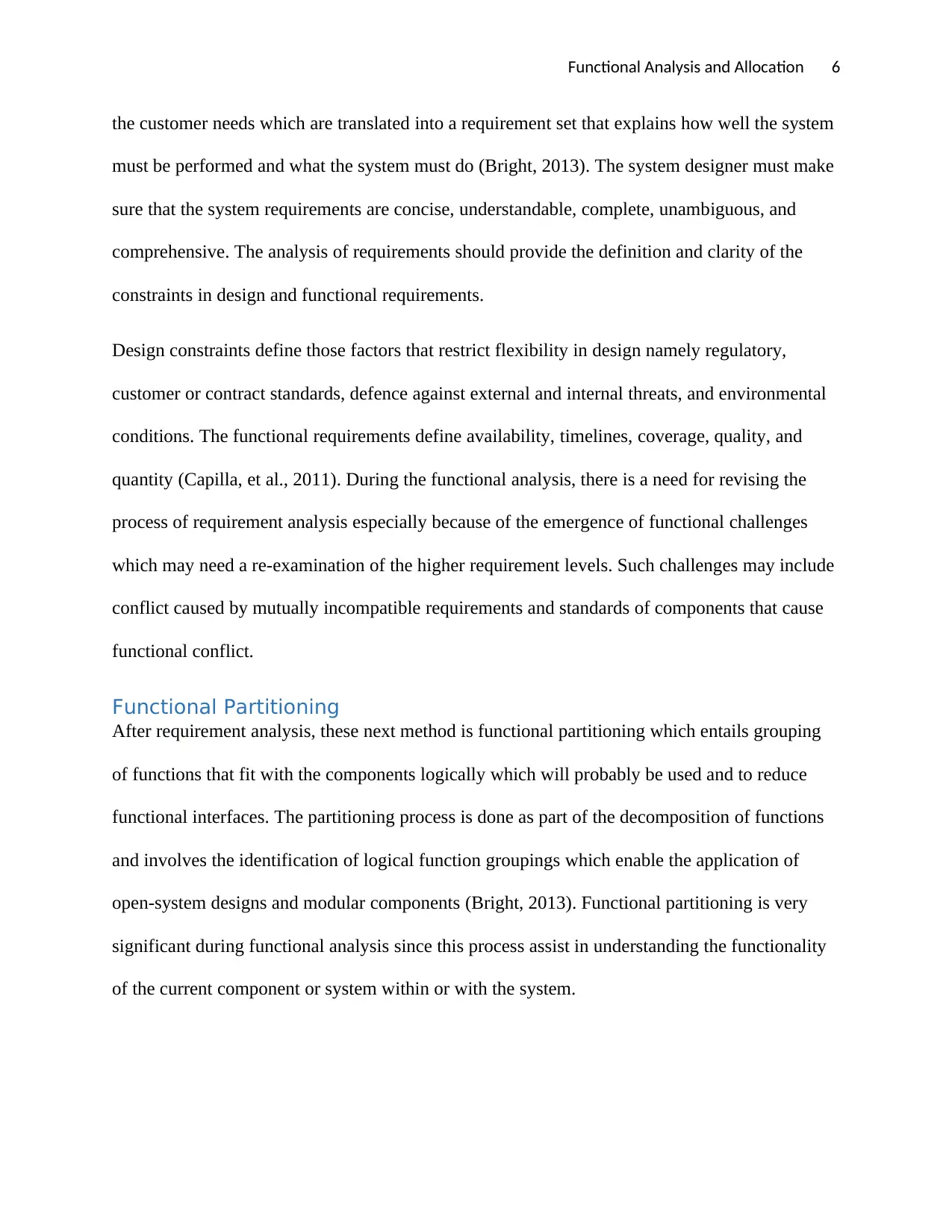
Functional Analysis and Allocation 6
the customer needs which are translated into a requirement set that explains how well the system
must be performed and what the system must do (Bright, 2013). The system designer must make
sure that the system requirements are concise, understandable, complete, unambiguous, and
comprehensive. The analysis of requirements should provide the definition and clarity of the
constraints in design and functional requirements.
Design constraints define those factors that restrict flexibility in design namely regulatory,
customer or contract standards, defence against external and internal threats, and environmental
conditions. The functional requirements define availability, timelines, coverage, quality, and
quantity (Capilla, et al., 2011). During the functional analysis, there is a need for revising the
process of requirement analysis especially because of the emergence of functional challenges
which may need a re-examination of the higher requirement levels. Such challenges may include
conflict caused by mutually incompatible requirements and standards of components that cause
functional conflict.
Functional Partitioning
After requirement analysis, these next method is functional partitioning which entails grouping
of functions that fit with the components logically which will probably be used and to reduce
functional interfaces. The partitioning process is done as part of the decomposition of functions
and involves the identification of logical function groupings which enable the application of
open-system designs and modular components (Bright, 2013). Functional partitioning is very
significant during functional analysis since this process assist in understanding the functionality
of the current component or system within or with the system.
the customer needs which are translated into a requirement set that explains how well the system
must be performed and what the system must do (Bright, 2013). The system designer must make
sure that the system requirements are concise, understandable, complete, unambiguous, and
comprehensive. The analysis of requirements should provide the definition and clarity of the
constraints in design and functional requirements.
Design constraints define those factors that restrict flexibility in design namely regulatory,
customer or contract standards, defence against external and internal threats, and environmental
conditions. The functional requirements define availability, timelines, coverage, quality, and
quantity (Capilla, et al., 2011). During the functional analysis, there is a need for revising the
process of requirement analysis especially because of the emergence of functional challenges
which may need a re-examination of the higher requirement levels. Such challenges may include
conflict caused by mutually incompatible requirements and standards of components that cause
functional conflict.
Functional Partitioning
After requirement analysis, these next method is functional partitioning which entails grouping
of functions that fit with the components logically which will probably be used and to reduce
functional interfaces. The partitioning process is done as part of the decomposition of functions
and involves the identification of logical function groupings which enable the application of
open-system designs and modular components (Bright, 2013). Functional partitioning is very
significant during functional analysis since this process assist in understanding the functionality
of the current component or system within or with the system.
⊘ This is a preview!⊘
Do you want full access?
Subscribe today to unlock all pages.

Trusted by 1+ million students worldwide
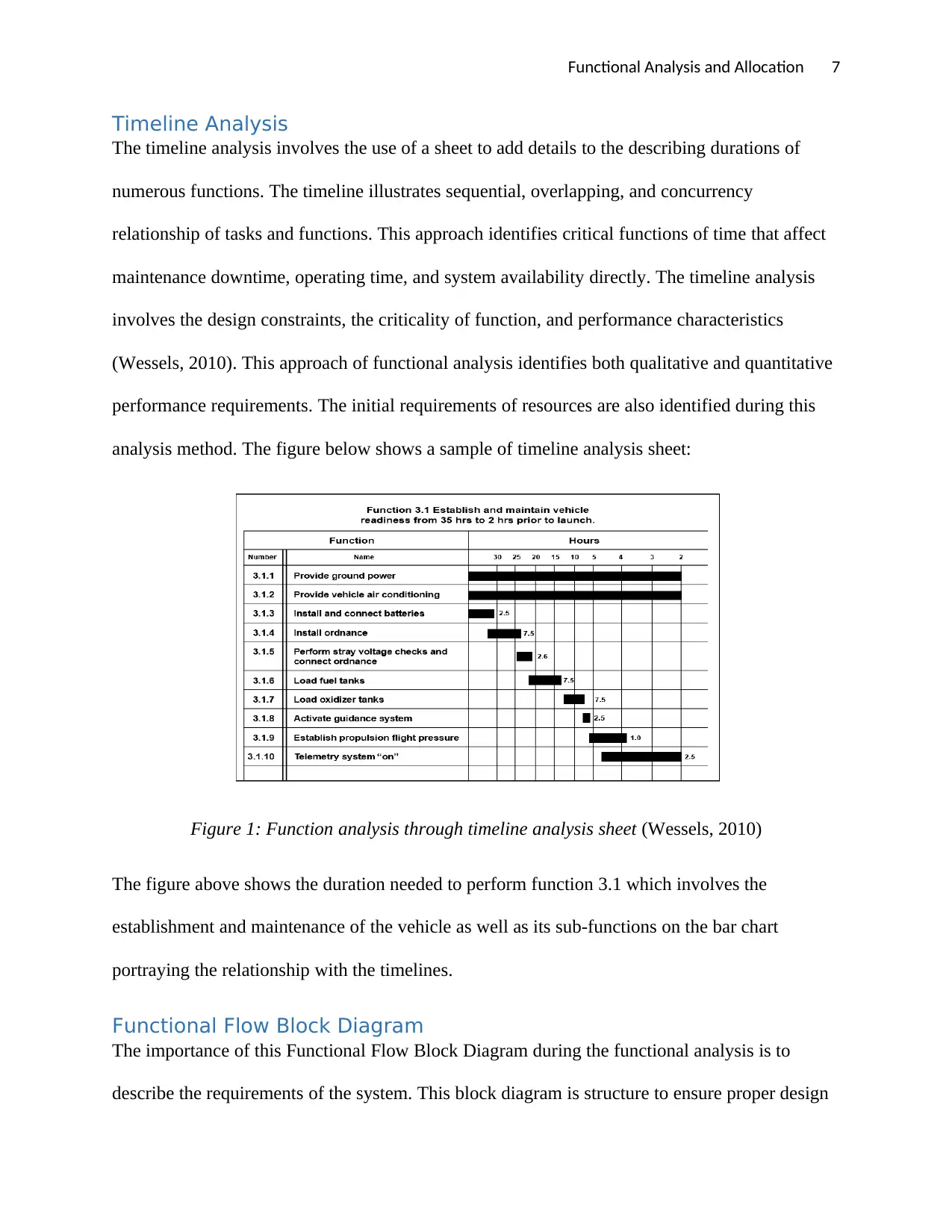
Functional Analysis and Allocation 7
Timeline Analysis
The timeline analysis involves the use of a sheet to add details to the describing durations of
numerous functions. The timeline illustrates sequential, overlapping, and concurrency
relationship of tasks and functions. This approach identifies critical functions of time that affect
maintenance downtime, operating time, and system availability directly. The timeline analysis
involves the design constraints, the criticality of function, and performance characteristics
(Wessels, 2010). This approach of functional analysis identifies both qualitative and quantitative
performance requirements. The initial requirements of resources are also identified during this
analysis method. The figure below shows a sample of timeline analysis sheet:
Figure 1: Function analysis through timeline analysis sheet (Wessels, 2010)
The figure above shows the duration needed to perform function 3.1 which involves the
establishment and maintenance of the vehicle as well as its sub-functions on the bar chart
portraying the relationship with the timelines.
Functional Flow Block Diagram
The importance of this Functional Flow Block Diagram during the functional analysis is to
describe the requirements of the system. This block diagram is structure to ensure proper design
Timeline Analysis
The timeline analysis involves the use of a sheet to add details to the describing durations of
numerous functions. The timeline illustrates sequential, overlapping, and concurrency
relationship of tasks and functions. This approach identifies critical functions of time that affect
maintenance downtime, operating time, and system availability directly. The timeline analysis
involves the design constraints, the criticality of function, and performance characteristics
(Wessels, 2010). This approach of functional analysis identifies both qualitative and quantitative
performance requirements. The initial requirements of resources are also identified during this
analysis method. The figure below shows a sample of timeline analysis sheet:
Figure 1: Function analysis through timeline analysis sheet (Wessels, 2010)
The figure above shows the duration needed to perform function 3.1 which involves the
establishment and maintenance of the vehicle as well as its sub-functions on the bar chart
portraying the relationship with the timelines.
Functional Flow Block Diagram
The importance of this Functional Flow Block Diagram during the functional analysis is to
describe the requirements of the system. This block diagram is structure to ensure proper design
Paraphrase This Document
Need a fresh take? Get an instant paraphrase of this document with our AI Paraphraser
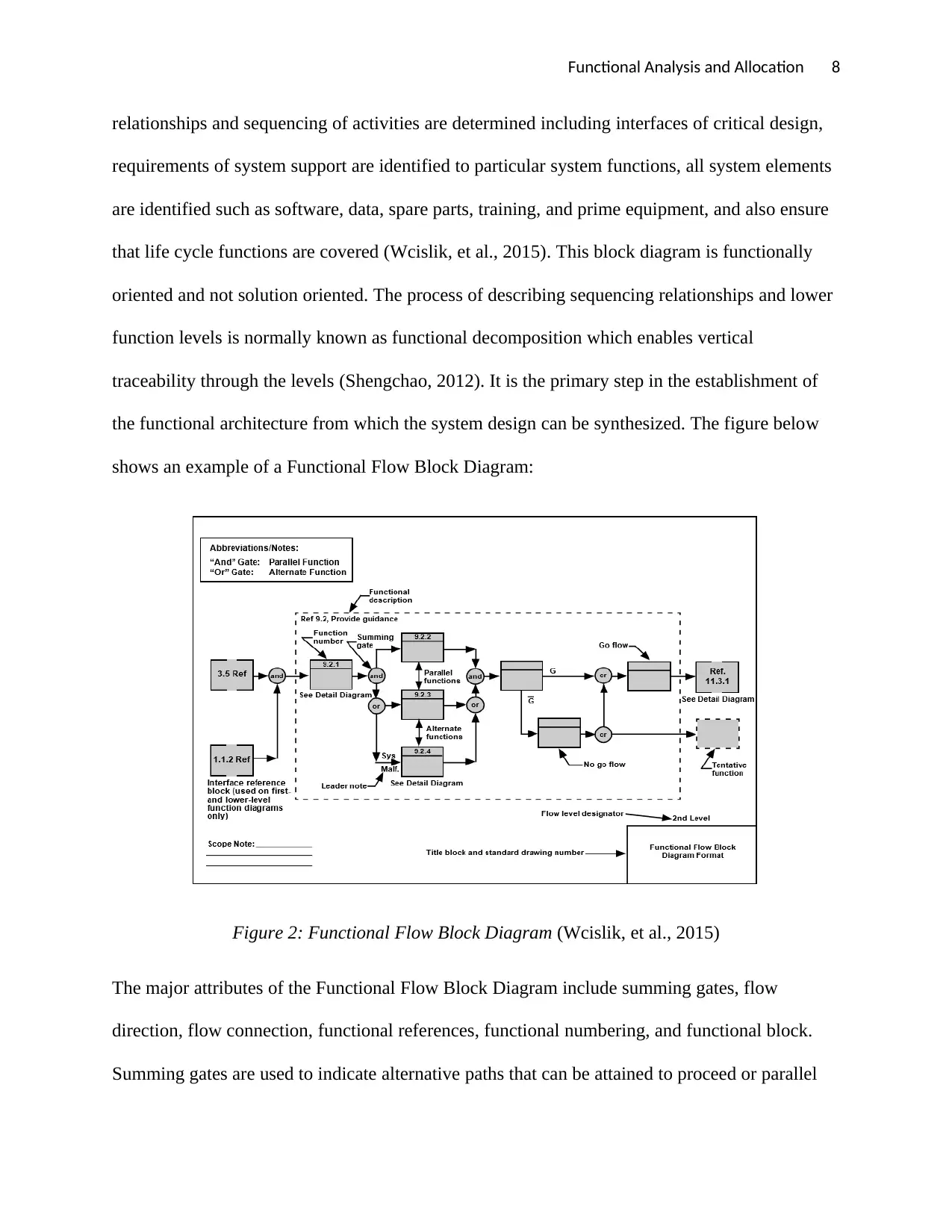
Functional Analysis and Allocation 8
relationships and sequencing of activities are determined including interfaces of critical design,
requirements of system support are identified to particular system functions, all system elements
are identified such as software, data, spare parts, training, and prime equipment, and also ensure
that life cycle functions are covered (Wcislik, et al., 2015). This block diagram is functionally
oriented and not solution oriented. The process of describing sequencing relationships and lower
function levels is normally known as functional decomposition which enables vertical
traceability through the levels (Shengchao, 2012). It is the primary step in the establishment of
the functional architecture from which the system design can be synthesized. The figure below
shows an example of a Functional Flow Block Diagram:
Figure 2: Functional Flow Block Diagram (Wcislik, et al., 2015)
The major attributes of the Functional Flow Block Diagram include summing gates, flow
direction, flow connection, functional references, functional numbering, and functional block.
Summing gates are used to indicate alternative paths that can be attained to proceed or parallel
relationships and sequencing of activities are determined including interfaces of critical design,
requirements of system support are identified to particular system functions, all system elements
are identified such as software, data, spare parts, training, and prime equipment, and also ensure
that life cycle functions are covered (Wcislik, et al., 2015). This block diagram is functionally
oriented and not solution oriented. The process of describing sequencing relationships and lower
function levels is normally known as functional decomposition which enables vertical
traceability through the levels (Shengchao, 2012). It is the primary step in the establishment of
the functional architecture from which the system design can be synthesized. The figure below
shows an example of a Functional Flow Block Diagram:
Figure 2: Functional Flow Block Diagram (Wcislik, et al., 2015)
The major attributes of the Functional Flow Block Diagram include summing gates, flow
direction, flow connection, functional references, functional numbering, and functional block.
Summing gates are used to indicate alternative paths that can be attained to proceed or parallel

Functional Analysis and Allocation 9
functions and all the conditions must be attained to proceed. The diagrams should be presented
so that the direction of flow is normally to the left from the right with the arrows indicating
functional flows (Shengchao, 2012). Every diagram should have a reference to other functional
diagrams by the use of a functional reference or box of brackets. Every level must have a
consistent number scheme and provide information related to the origin of the function. These
numbers provide relationships and identification that will carry through allocation activities and
functional analysis. Every function of the Functional Flow Block Diagram should be separated
and denoted by one solid line or box.
APPROACHES FOR FUNCTIONAL ALLOCATION
This is the third major step in the Functional Analysis and Allocation of a system engineering
design is the functional allocation. Functional allocation is a process by which all the
requirements at the top level are assigned to a single or numerous function for the purposes of
implementation (Kumar & Suresh, 2018). Some of the approaches for functional allocation
include verification, functional architecture, design synthesis, and requirement allocation.
Design Synthesis
Synthesis of design is the process of defining the item or product in regards to their software and
physical elements which together define or make up the product or system. The result is
normally known as the physical architecture and every section may support numerous functions
and each section must attain many functional requirements (Ahlquist & Menges, 2012). The
physical architecture is the major structure for producing the baselines and specification which
are important during functional allocation.
Functional Architecture
The functional architecture can be defined as a decomposition of top-down performance
requirements and functional system. The functional architecture shows the logical sequence of
functions and all the conditions must be attained to proceed. The diagrams should be presented
so that the direction of flow is normally to the left from the right with the arrows indicating
functional flows (Shengchao, 2012). Every diagram should have a reference to other functional
diagrams by the use of a functional reference or box of brackets. Every level must have a
consistent number scheme and provide information related to the origin of the function. These
numbers provide relationships and identification that will carry through allocation activities and
functional analysis. Every function of the Functional Flow Block Diagram should be separated
and denoted by one solid line or box.
APPROACHES FOR FUNCTIONAL ALLOCATION
This is the third major step in the Functional Analysis and Allocation of a system engineering
design is the functional allocation. Functional allocation is a process by which all the
requirements at the top level are assigned to a single or numerous function for the purposes of
implementation (Kumar & Suresh, 2018). Some of the approaches for functional allocation
include verification, functional architecture, design synthesis, and requirement allocation.
Design Synthesis
Synthesis of design is the process of defining the item or product in regards to their software and
physical elements which together define or make up the product or system. The result is
normally known as the physical architecture and every section may support numerous functions
and each section must attain many functional requirements (Ahlquist & Menges, 2012). The
physical architecture is the major structure for producing the baselines and specification which
are important during functional allocation.
Functional Architecture
The functional architecture can be defined as a decomposition of top-down performance
requirements and functional system. The functional architecture shows the logical sequence of
⊘ This is a preview!⊘
Do you want full access?
Subscribe today to unlock all pages.

Trusted by 1+ million students worldwide
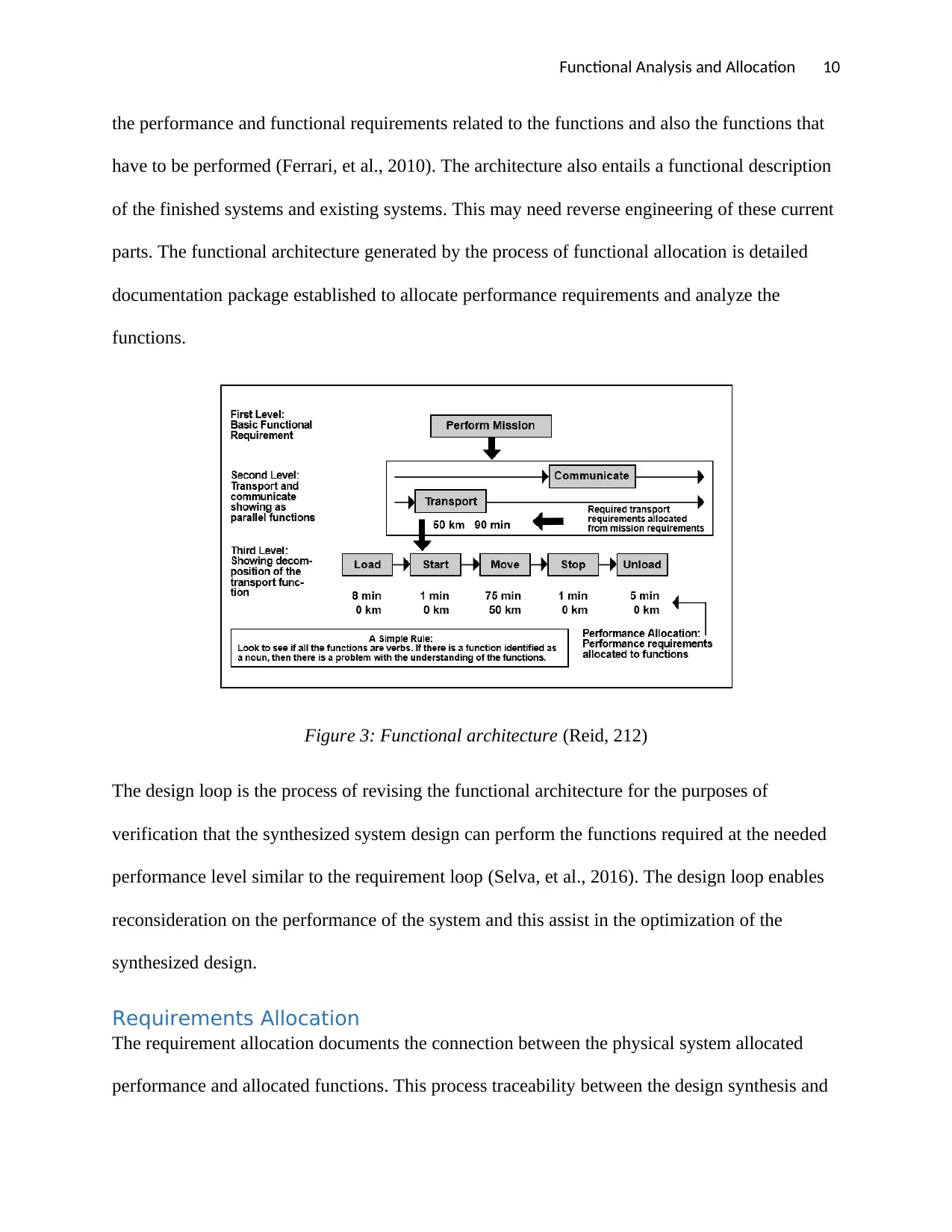
Functional Analysis and Allocation 10
the performance and functional requirements related to the functions and also the functions that
have to be performed (Ferrari, et al., 2010). The architecture also entails a functional description
of the finished systems and existing systems. This may need reverse engineering of these current
parts. The functional architecture generated by the process of functional allocation is detailed
documentation package established to allocate performance requirements and analyze the
functions.
Figure 3: Functional architecture (Reid, 212)
The design loop is the process of revising the functional architecture for the purposes of
verification that the synthesized system design can perform the functions required at the needed
performance level similar to the requirement loop (Selva, et al., 2016). The design loop enables
reconsideration on the performance of the system and this assist in the optimization of the
synthesized design.
Requirements Allocation
The requirement allocation documents the connection between the physical system allocated
performance and allocated functions. This process traceability between the design synthesis and
the performance and functional requirements related to the functions and also the functions that
have to be performed (Ferrari, et al., 2010). The architecture also entails a functional description
of the finished systems and existing systems. This may need reverse engineering of these current
parts. The functional architecture generated by the process of functional allocation is detailed
documentation package established to allocate performance requirements and analyze the
functions.
Figure 3: Functional architecture (Reid, 212)
The design loop is the process of revising the functional architecture for the purposes of
verification that the synthesized system design can perform the functions required at the needed
performance level similar to the requirement loop (Selva, et al., 2016). The design loop enables
reconsideration on the performance of the system and this assist in the optimization of the
synthesized design.
Requirements Allocation
The requirement allocation documents the connection between the physical system allocated
performance and allocated functions. This process traceability between the design synthesis and
Paraphrase This Document
Need a fresh take? Get an instant paraphrase of this document with our AI Paraphraser
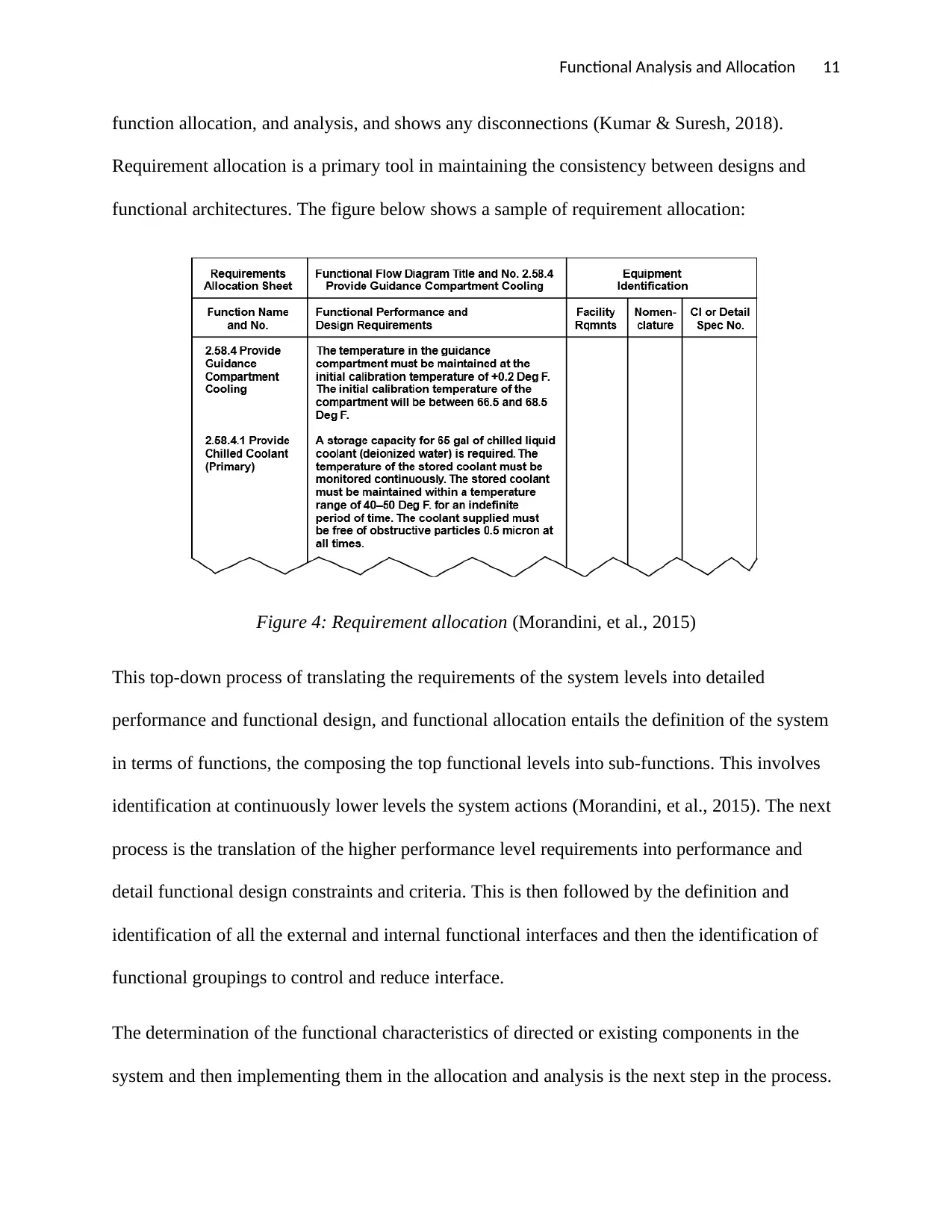
Functional Analysis and Allocation 11
function allocation, and analysis, and shows any disconnections (Kumar & Suresh, 2018).
Requirement allocation is a primary tool in maintaining the consistency between designs and
functional architectures. The figure below shows a sample of requirement allocation:
Figure 4: Requirement allocation (Morandini, et al., 2015)
This top-down process of translating the requirements of the system levels into detailed
performance and functional design, and functional allocation entails the definition of the system
in terms of functions, the composing the top functional levels into sub-functions. This involves
identification at continuously lower levels the system actions (Morandini, et al., 2015). The next
process is the translation of the higher performance level requirements into performance and
detail functional design constraints and criteria. This is then followed by the definition and
identification of all the external and internal functional interfaces and then the identification of
functional groupings to control and reduce interface.
The determination of the functional characteristics of directed or existing components in the
system and then implementing them in the allocation and analysis is the next step in the process.
function allocation, and analysis, and shows any disconnections (Kumar & Suresh, 2018).
Requirement allocation is a primary tool in maintaining the consistency between designs and
functional architectures. The figure below shows a sample of requirement allocation:
Figure 4: Requirement allocation (Morandini, et al., 2015)
This top-down process of translating the requirements of the system levels into detailed
performance and functional design, and functional allocation entails the definition of the system
in terms of functions, the composing the top functional levels into sub-functions. This involves
identification at continuously lower levels the system actions (Morandini, et al., 2015). The next
process is the translation of the higher performance level requirements into performance and
detail functional design constraints and criteria. This is then followed by the definition and
identification of all the external and internal functional interfaces and then the identification of
functional groupings to control and reduce interface.
The determination of the functional characteristics of directed or existing components in the
system and then implementing them in the allocation and analysis is the next step in the process.
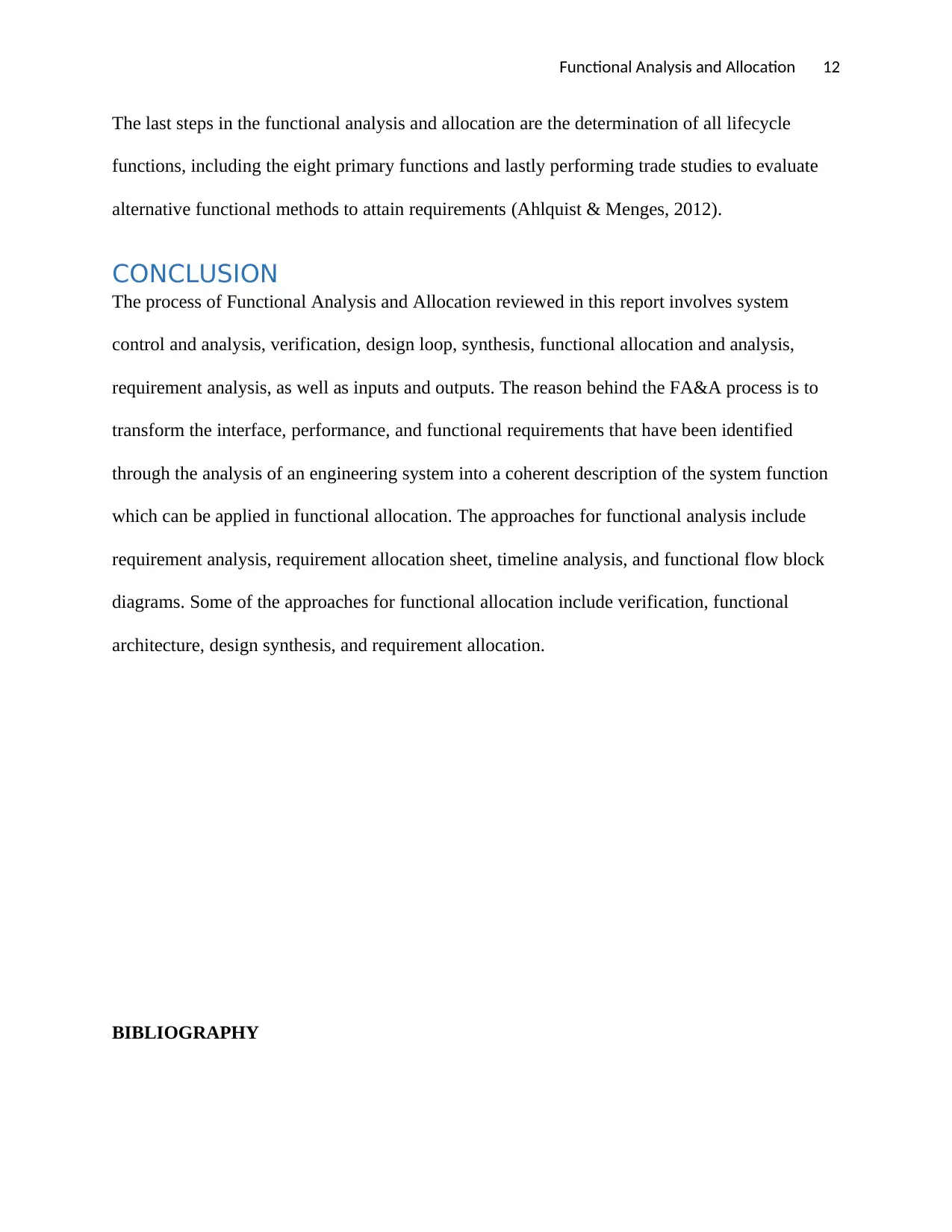
Functional Analysis and Allocation 12
The last steps in the functional analysis and allocation are the determination of all lifecycle
functions, including the eight primary functions and lastly performing trade studies to evaluate
alternative functional methods to attain requirements (Ahlquist & Menges, 2012).
CONCLUSION
The process of Functional Analysis and Allocation reviewed in this report involves system
control and analysis, verification, design loop, synthesis, functional allocation and analysis,
requirement analysis, as well as inputs and outputs. The reason behind the FA&A process is to
transform the interface, performance, and functional requirements that have been identified
through the analysis of an engineering system into a coherent description of the system function
which can be applied in functional allocation. The approaches for functional analysis include
requirement analysis, requirement allocation sheet, timeline analysis, and functional flow block
diagrams. Some of the approaches for functional allocation include verification, functional
architecture, design synthesis, and requirement allocation.
BIBLIOGRAPHY
The last steps in the functional analysis and allocation are the determination of all lifecycle
functions, including the eight primary functions and lastly performing trade studies to evaluate
alternative functional methods to attain requirements (Ahlquist & Menges, 2012).
CONCLUSION
The process of Functional Analysis and Allocation reviewed in this report involves system
control and analysis, verification, design loop, synthesis, functional allocation and analysis,
requirement analysis, as well as inputs and outputs. The reason behind the FA&A process is to
transform the interface, performance, and functional requirements that have been identified
through the analysis of an engineering system into a coherent description of the system function
which can be applied in functional allocation. The approaches for functional analysis include
requirement analysis, requirement allocation sheet, timeline analysis, and functional flow block
diagrams. Some of the approaches for functional allocation include verification, functional
architecture, design synthesis, and requirement allocation.
BIBLIOGRAPHY
⊘ This is a preview!⊘
Do you want full access?
Subscribe today to unlock all pages.

Trusted by 1+ million students worldwide
1 out of 14